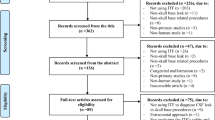Abstract
Purpose
Several diagnostic modalities are used to detect CSF leaks. Intraoperative use of intrathecal fluorescein can help to detect and localize a CSF leak simultaneously. However, it is not FDA approved, the application is invasive and has serious complications. Topical fluorescein is reported to be a safe and sensitive alternative to ITF. In this study, we aimed to evaluate the effectiveness of topical fluorescein in CSF leak closure.
Methods
This retrospective study includes 27 consecutive patients (19 women, 8 men) who underwent endoscopic endonasal CSF leak closure using topical fluorescein, between 2011 and 2017.
Results
In two patients, radiologic studies false positively locate the defect. β2 transferrin and topical fluorescein tests were positive in these patients. Both cases needed a second operation.
Conclusion
If radiologic studies fail to locate the defect properly, topical fluorescein only confirms the CSF leak, but the defect cannot be located anatomically intraoperatively.



Similar content being viewed by others
References
Kljajić V, Vuleković P, Vlaški L, Savović S, Dragičević D, Papić V (2017) Endoscopic repair of cerebrospinal fluid rhinorrhea. Braz J Otorhinolaryngol 83(4):388–393
LaFata V, McLean N, Wise SK, DelGaudio JM, Hudgins PA (2008) CSF leaks: correlation of high-resolution CT and multiplanar reformations with intraoperative endoscopic findings. AJNR Am J Neuroradiol. 29:536–541
Lloyd KM, DelGaudio JM, Hudgins PA (2008) Imaging of skull base cerebrospinal fluid leaks in adults. Radiology. 248:725–736
Lam A, Holbrook E (2013) Skullbase anatomy and CSF rhinorrhea. Adv Otorhinolaryngol 74:1–11
Banua MA, Kima JH, Shina BJ, Woodworth GF, Anand VK, Schwartz TH (2014) Low-dose intrathecal fluorescein and etiology-based graft choice in the endoscopic endonasal closure of CSF leaks. Clin Neurol Neurosurg 116:28–34
Jones ME, Reino T, Gnoy A, Guillory S, Wackym P, Lawson W (2000) Identification of intranasal cerebrospinal fluid leaks by topical application with fluorescein dye. Am J Rhinol. 14:93–96
Liu HS, Chen YT, Wang D et al (2009) The use of topical intranasal fluorescein in the endoscopic endonasal repair of cerebrospinal fluid rhinorrhea. Surg Neurol 72:341–346
Ozturk K, Karabagli H, Bulut S, Egilmez M, Duran M (2012) Is the use of topical fluorescein helpful for management of CSF leakage? Laryngoscope 122:1215–1218
Felisati G, Bianchi A, Lozza P, Portaleone S (2008) Italian multicentre study on intrathecal fluorescein for craniosinusal fistulae. Acta Otorhinolaryngol Ital 28:159–63
Oakley GM, Alt JA, Schlosser RJ et al (2016) Diagnosis of cerebrospinal fluid rhinorrhea: an evidence-based review with recommendations. Int Forum Allergy Rhinol 6(1):8–16
Moseley JI, Carton CA, Stern WE (1978) The spectrum of complications in the use of intrathecal fluorescein. J Neurosurg. 48(5):765–7
Seth R, Rajasekaran K, Benninger MS et al (2010) The utility of intrathecal fluorescein in cerebrospinal fluid leak repair. Otolaryngol Head Neck Surg 143(5):626–32
Gonen L, Monteiro E, Klinomoros G et al (2015) Endoscopic endonasal repair of spontaneous and traumatic cerebrospinal fluid rhinorrhea a review and local experience. Neurosurg Clin N Am. 26:333–348
Saafan ME, Ragab SM, Albirmawy OA (2006) Topical intranasal fluorescein: the missing partner in algorithms of cerebrospinal fluid fistula detection. Laryngoscope 116(7):1158–61
Xie T, Sun W, Zhang X et al (2016) The value of 3D-FIESTA MRI in detecting non-iatrogenic cerebrospinal fluid rhinorrhoea: correlations with endoscopic endonasal surgery. Acta Neurochir (Wien). 158(12):2333–2339
Acknowledgements
A part of this study was presented as an oral abstract in the 4th Congress of European ORL-HNS.
Funding
This study has not received any specifc funding.
Author information
Authors and Affiliations
Corresponding author
Ethics declarations
Conflict of interest
The authors declare that they have no conflict of interest.
Ethical approval
All procedures performed in studies involving human participants were in accordance with the ethical standards of the institutional and/or national research committee and with the 1964 Helsinki Declaration and its later amendments or comparable ethical standards.
Informed consent
Informed consent was obtained from all individual participants included in the study.
Additional information
Publisher's Note
Springer Nature remains neutral with regard to jurisdictional claims in published maps and institutional affiliations.
Rights and permissions
About this article
Cite this article
Eren, E., Güvenç, G., İşlek, A. et al. Is topical fluorescein that effective in endoscopic CSF leak closure?. Eur Arch Otorhinolaryngol 277, 1073–1077 (2020). https://doi.org/10.1007/s00405-019-05766-1
Received:
Accepted:
Published:
Issue Date:
DOI: https://doi.org/10.1007/s00405-019-05766-1




